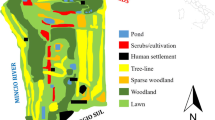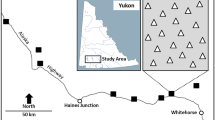Abstract
Following the introduction of the grey squirrel (Sciurus carolinensis) to Ireland in 1911, the species quickly established and spread to cover the eastern half of Ireland. Historically, the River Shannon has delineated the western boundary of its distribution in Ireland, however the factors limiting the spread of the species westwards were unclear. The aims of this study were to assess the current squirrel distribution in the area directly bordering the River Shannon, and to identify habitat types and landscape characteristics that could be facilitating or impeding the spread of grey squirrels in Ireland. The current distribution was established through hair tube and live trapping surveys and through sightings from a citizen science survey. Grey squirrels are absent or in very low numbers in much of the study area. In some areas, red squirrels have reappeared where they previously had been displaced by the grey squirrel. Discriminant function analysis was used to identify significant differences in habitat types and landscape characteristics between a region with high grey squirrel occurrence records and a region where they are now rare. Several landscape attributes were found to be significantly different, including the presence of pine marten, water bodies, peatland and coniferous forests. The area in which grey squirrels have disappeared overlaps with the core pine marten population range, and in a landscape that is more fragmented than the areas in which grey squirrel are continuing to be invasive. The demise of the grey squirrel in Ireland is more widespread than previously believed.





Similar content being viewed by others
References
Bertolino S (2008) Introduction of the American grey squirrel (Sciurus carolinensis) in Europe: a case study in biological invasion. Curr Sci 95:903–906
Carey M, Hamilton G, Poole A, Lawton C (2007) The Irish squirrel survey 2007. Council for Forestry Research and Development (COFORD), Dublin
CBD (2010) Global biodiversity outlook 3. Secretariat of the Convention on Biological Diversity, Montréal
Coillte (2011a) Ballymahon forest (LD03), forest management plan. Coillte, Wicklow
Coillte (2011b) Castlepollard forest (WH01), forest management plan. Coillte, Wicklow
Coillte (2011c) Curragh Chase forest (LK02), forest management plan. Coillte, Wicklow
Fairley J (1984) An Irish beast book: a natural history of Ireland’s furred wildlife, 2nd edn. Blackstaff Press, Belfast
Forest Service (2014) Ireland’s forest—annual statistics. Department of Agriculture, Food and the Marine. http://www.agriculture.gov.ie/forestservice/ Accessed 11 Dec 2014
Foulkes N, Fuller J, Little D, McCourt S, Murphy P (2013) Hedgerow appraisal system—best practise guidance on hedgerow survey, data collation and appraisal. Woodlands of Ireland, Dublin
Goldstein EA, Lawton C, Sheehy E, Butler F (2014) Locating species range frontiers: a cost and efficiency comparison of citizen science and hair-tube survey methods for use in tracking an invasive squirrel. Wildl Res 41:64–75. https://doi.org/10.1071/WR13197
Gurnell J, Lurz P, Bertoldi W (2014) The changing patterns in the distribution of red and grey squirrels in the North of England and Scotland between 1991 and 2010 based on volunteer surveys. Hystrix Ital J Mammal 25:83–89. https://doi.org/10.4404/hystrix-25.2-9988
Henderson JA (1947) Grey squirrel in Co. Fermanagh. Ir Nat J 9:97
Kelly J, Tosh D, Dale K, Jackson A (2013) The economic cost of invasive and non-native species in Ireland and Northern Ireland. The Northern Ireland Environment Agency and the National Parks and Wildlife Service, Belfast
Koprowski JL (1994) Sciurus carolinensis. Am Soc Mammal 480:1–9
Koprowski JL (2005) The response of tree squirrels to fragmentation: a review and synthesis. Anim Conserv 8:369–376
Lawton C (2003) Controlling grey squirrel damage in Irish broadleaved woodlands. COFORD Connects, Silviculture/Management No. 7. Council for Forestry Research and Development
Lawton C, Rochford J (2007) The recovery of grey squirrel (Sciurus carolinensis) populations after intensive control programmes. Proc R Ir Acad Biol Environ 107B:19–29
Lever C (2009) The naturalized animals of Britain and Ireland. New Holland Publishers (UK) Ltd., London
Lowe VPW, Lane M, Barr C (2007) A history of the grey squirrel (Sciurus carolinensis) invasion of Cumbria. Naturalist 132:9–22
McGoldrick M (2011) The vagility of an invasive species, the grey squirrel (Sciurus carolinensis)—studies of population genetic structure, control and recolonisation, range expansion and pox virus. Trinity College Dublin, Dublin
McGoldrick M, Rochford J (2009) Recent range expansion by the grey squirrel (Sciurus carolinensis Gmelin 1788). Ir Nat J 30:24–28
Moffat CB (1938) The mammals of Ireland. Proc R Ir Acad Sect B Biol Geol Chem Sci 44:61–128
Moutou F, Pastoret PP (2010) Invasive mammals Revue Scientifique Et Technique. Off Int Epizoot 29:209–216
Ní Lamhna E (1979) Provisional distribution atlas of amphibian, reptiles and mammals in Ireland, 2nd edn. An Foras Forbatha, Dublin
O’Mahony D, O’Reilly C, Turner P (2012) Pine marten (Martes martes) distributon and abundance in Ireland: a cross-jurisdictional analysis using non-invasive genetic survey techniques. Mammal Biol 77:351–357
O’Sullivan A, Moore J (1979) The composition of field boundaries. In: Houghton JP (ed) Atlas of Ireland. RIA, Dublin
O’Teangana D, Reilly S, Montgomery WI, Rochford J (2000) Distribution and status of red squirrel (Sciurus vulgaris) and grey squirrel (Sciurus carolinensis) in Ireland. Mammal Rev 30:45–55
Reilly S (1997) Aspects of the ecology of the red squirrel, Sciurus vulgaris, in commerical conifer forests. Trinity College Dublin, Dublin
Schuchert P, Shuttleworth CM, McInnes C, Everest DJ, Rushton SP (2014) Landscape scale impacts of culling upon a European grey squirrel population: Can trapping reduce population size and decrease the threat of squirrelpox virus infection for the native red squirrel? Biol Invasions 16:2381–2391. https://doi.org/10.1007/s10530-014-0671-8
Sheehy E, Lawton C (2014) Population crash in an invasive species following the recovery of a native predator: the case of the American grey squirrel and the European pine marten in Ireland. Biodivers Conserv 23:753–774. https://doi.org/10.1007/s10531-014-0632-7
Sheehy E, O’Meara DB, O’Reilly C, Smart A, Lawton C (2013) A non-invasive approach to determining pine marten abundance and predation. Eur J Wildl Res. https://doi.org/10.1007/s10344-013-0771-2
Sheehy E, Sutherland C, O’Reilly C, Lambin X (2018) The enemy of my enemy is my friend: native pine marten recovery reverses the decline of the red squirrel by suppressing grey squirrel populations. Proc R Soc B Biol Sci. https://doi.org/10.1098/rspb.2017.2603
Shorten M (1954) Squirrels. A new naturalist special volume. Collins, St. James Place, London
Shuttleworth CM, Halliwell EC, Robertson PA (2016) Identifying incursion pathways, early detection responses and management actions to prevent grey squirrel range expansion: an island case study in Wales. In: Shuttleworth CM, Lurz PWW, Gurnell J (eds) The grey squirrel—ecology and management of an invasive species in Europe. European Squirrel Initiative, Woodbridge, pp 475–492
Signorile AL, Shuttleworth CM (2016) Genetic evidence of the effectiveness of grey squirrel control operations: lessons from the Isle of Anglesey. In: Shuttleworth CM, Lurz PWW, Gurnell J (eds) The grey squirrel—ecology & management of an invasive species in Europe. European Squirrel Initiative, Woodbridge, pp 439–451
Signorile AL, Wang J, Lurz PWW, Bertolino S, Carbone C, Reuman DC (2014) Do founder size, genetic diversity and structure influence rates of expansion of North American grey squirrels in Europe? Divers Distrib 20:918–930
Signorile AL, Reuman DC, Lurz PWW, Bertolino S, Carbone C, Wang J (2016) Using DNA profiling to investigate human-mediated translocations of an invasive species. Biol Conserv 195:97–105. https://doi.org/10.1016/j.biocon.2015.12.026
Stelfox AW (1927) The grey squirrel spreads to Westmeath Irish. Nat J 1:275
Stevenson C, Ramsey AD, Nevin OT, Sinclair W (2012) Assessing grey squirrel dispersal patterns within the landscape using sequence variation. Landsc Res 38:553–559
Stevenson C, Ferryman M, Nevin OT, Ramsey AD, Bailey S, Watts K (2013) Using GPS telemetry to validate least-cost modelling of gray squirrel (Sciurus carolinensis) movement within a fragmented landscape. Ecol Evol 3:2350–2361. https://doi.org/10.1002/ece3.638
Stevenson-Holt CD, Sinclair W (2014) Assessing the geographic origin of the invasive grey squirrel using DNA sequencing: implications for management strategies. Glob Ecol Conserv 3:20–27
Teerink BJ (1991) Hair of west-European mammals. Cambridge University Press, Cambridge
Warner P (1976) The status of squirrels in Ireland and their significance as forest pests. Forest and Wildlife Service (now National Parks & Wildlife Service), Dublin
Watt HB (1923) The American grey squirrel in Ireland. Ir Nat J 32:95
Wittenberg R, Cock MJW (2001) Invasive alien species: a toolkit of best prevention and management practices. CABI Publishing, Wallingford
Acknowledgements
Margaret Flaherty was funded by Department of Agriculture, Food and the Marine of the Irish Government under the National Development Plan 2007–2013. We would like to thank Michael Carey, Emily Goldstein and Emma Sheehy for contributing to the sightings data; woodland owners and managers in particular Coillte and National Parks & Wildlife Service (Department of Culture, Heritage and the Gaeltacht) for access to woodlands and facilitating trapping studies; citizen scientists for contributing to the survey as well as the National Biodiversity Data Centre, the Centre for Environmental Data and Records, the National and Regional Game Councils, the Forest Service (Northern Ireland), technical staff and students at NUI Galway for assistance with field work.
Funding
This study was funded by the Department of Agriculture, Food and the Marine of the Irish Government (Grant No. 10/RD/WIGS/NUIG/719).
Author information
Authors and Affiliations
Corresponding author
Additional information
Publisher's Note
Springer Nature remains neutral with regard to jurisdictional claims in published maps and institutional affiliations.
Rights and permissions
About this article
Cite this article
Flaherty, M., Lawton, C. The regional demise of a non-native invasive species: the decline of grey squirrels in Ireland. Biol Invasions 21, 2401–2416 (2019). https://doi.org/10.1007/s10530-019-01987-x
Received:
Accepted:
Published:
Issue Date:
DOI: https://doi.org/10.1007/s10530-019-01987-x




